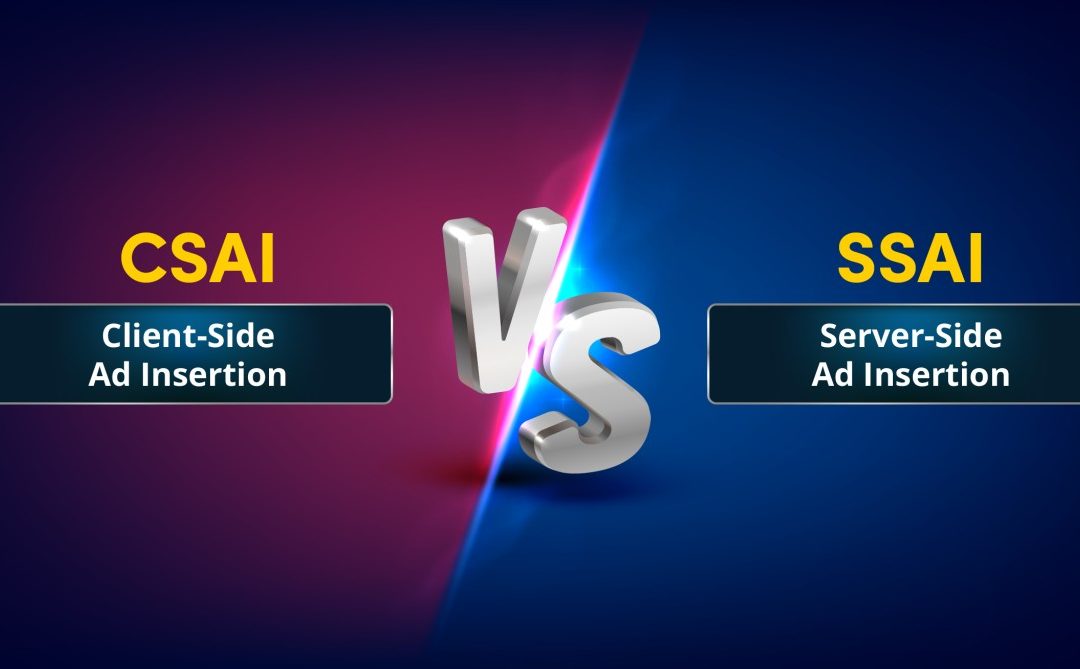In the dynamic realm of online video advertising, two prominent technologies, CSAI and SSAI, take the spotlight for their role in ad insertions. Delivering targeted and engaging ads to viewers through these methods is crucial for maximizing revenue and enhancing the user experience.
In this article, we will explore the key distinctions between CSAI and SSAI, highlighting their advantages and drawbacks to help you make informed decisions when implementing video ad strategies.
CSAI (Client-Side Ad Insertion)
CSAI, also known as Client-Side Ad Stitching or Client-Side Ad Insertion, is a traditional method of serving ads in online video content. In CSAI, ad requests and rendering occur on the client-side (user’s device), typically within the video player itself. When a video ad break is triggered, the video player reaches out to the ad server to fetch the ad creatives. The ad creatives are then stitched together with the video content and presented to the viewer.
Advantages of CSAI:
- Real-Time Ad Personalization: CSAI enables real-time targeting and personalization, allowing advertisers to deliver ads based on user data, demographics, and viewing behavior.
- Easy Integration: Implementing CSAI is relatively straightforward, as it requires minimal server-side modifications. Video players with built-in ad support can easily accommodate CSAI.
- Accurate Ad Metrics: Since ad rendering occurs on the client-side, CSAI provides accurate ad viewability and engagement metrics.
Drawbacks of CSAI:
- Ad-Blocker Vulnerability: CSAI is susceptible to ad-blockers, potentially leading to a loss in ad revenue.
- Latency and Buffering: The ad fetching process in CSAI can introduce latency and buffering time, leading to potential viewer frustration.
SSAI (Server-Side Ad Insertion)
SSAI, also known as Ad Stitching or Ad Insertion, is an advanced technology that dynamically inserts ads on the server-side before delivering the video content to the viewer’s device. In SSAI, the ad insertion process takes place on the content distributor’s server.
Advantages of SSAI:
- Ad-Blocker Resilience: As ad stitching happens on the server-side, SSAI reduces vulnerability to ad-blockers, ensuring a more reliable ad delivery and revenue stream.
- Reduced Latency: SSAI eliminates the ad fetching process on the client-side, significantly reducing latency and buffering issues.
- Seamless Viewing Experience: Viewers experience smooth transitions between video content and ads, as the stitching process ensures ads are seamlessly integrated.
Drawbacks of SSAI:
- Limited Real-Time Personalization: Compared to CSAI, SSAI may offer slightly less real-time ad personalization, as targeting decisions are made on the server-side.
- Metrics Challenges: SSAI can present some complexities in measuring ad viewability accurately, as the video player may not have visibility into the actual ad playback
So, Should I Choose CSAI Or SSAI?
Both CSAI and SSAI have their pros and cons and have their place in ad-serving technology for OTT. There is no argument about that!
However, if one was worried about sticking to CSAI or moving to SSAI, I feel the first thing they should do is engage with an ad-tracking service (independent, 3rd party) and get hold of fundamental data on how their ads are performing –
- Is there a lot of latency, buffering?
- What are the fill-rates?
- Where are most of the errors coming from?
- What is the cost of maintaining CSAI on all the devices we support?
- What are the completion-rates of the ads? Do people continue watching the content after the ad?
- Are my marketing campaigns dependent on interactivity?
- And so on.
Getting concrete, unbiased, raw data will help a publisher make the right decision whether to use CSAI or SSAI. Such data-driven decisions will positively impact revenue and, most importantly, the user experience!


Recent Comments